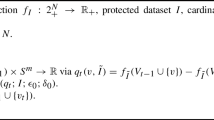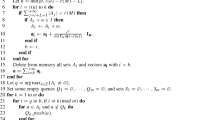Abstract
We propose a private algorithm for the problem of maximizing a submodular but not necessary monotone set function over a down-closed family of sets. The constraint is very general since it includes some important and typical constraints such as knapsack and matroid constraints. Our algorithm Differentially Private Measure Continuous Greedy is proved to be \({\mathcal {O}}(\epsilon )\)-differential private. For the multilinear relaxation of the above problem, it yields \(\left( Te^{-T}-o(1)\right) \)-approximation guarantee with additive error \({\mathcal {O}}\left( \frac{2\varDelta }{\epsilon n^4}\right) \), where \(T\in [0,1]\) is the stopping time of the algorithm, \(\varDelta \) is the defined sensitivity of the objective function, which is associated to a sensitive dataset, and n is the size of the given ground set. For a specific matroid constraint, we could obtain a discrete solution with near 1/e-approximation guarantee and same additive error by lossless rounding technique. Besides, our algorithm can be also applied in monotone case. The approximation guarantee is \(\left( 1-e^{-T}-o(1)\right) \) when the submodular set function is monotone. Furthermore, we give a conclusion in terms of the density of the relaxation constraint, which is always at least as good as the tight bound \((1-1/e)\).
Similar content being viewed by others
Availability of data and material
Enquiries about data availability should be directed to the authors.
References
Abadi M, Chu A, Goodfellow I, McMahan HB, Mironov I, Talwar K, Zhang L (2016) Deep learning with differential privacy. In Proceedings of the 23rd ACM SIGSAC Conference on Computer and Communications Security, p 308-318
Ageev A, Sviridenko M (1999) An \(0.828\) approximation algorithm for the uncapacitated facility location problem. Discrete Appl Math 93(2/3):149–156
Alon N, Spencer JH (2004) The probabilistic method. John Wiley & Sons 3:307–314
Austrin P, Benabbas S, Georgiou K (2016) Better balance by being biased: A \(0.8776\)-approximation for max bisection. The ACM Transactions on Algorithms 13(1):1–27
Bach FR (2013) Learning with submodular functions: a convex optimization perspective. Foundations and Trends in Machine Learning 6(2–3):145–373
Bu ZQ, Gopi S, Kulkarni J, Lee YT, Shen JH (2021) Tantipongpipat U. Fast and memory efficient differentially private-SGD via JL projections. In arXiv: 2102.03013
Buchbinder N, Feldman M, Naor JS, Schwart R (2014) Submodular maximization with cardinality constraints. In Proceedings of the 25th Annual ACM-SIAM Symposium on Discrete Algorithms, p 1433-1452
Călinescu G, Chekuri C, Pál M, Vondrák J (2011) Maximizing a monotone submodular function subject to a matroid constraint. SIAM J Comput 40(6):1740–1766
Chekuri C, Jayram T S, Vondrák J (2015) On multiplicative weight updates for concave and submodular function maximization. In Proceedings of the 6th Innovations in Theoretical Computer Science, p 201-210
Chekuri C, Khanna S (2005) A polynomial time approximation scheme for the multiple knapsack problem. In SIAM J Comput 35(3):713–728
Chekuri C, Vondrák J, Zenklusen R (2010) Dependent randomized rounding for matroid polytopes and applications. In Proceedings of the 51st Annual Symposium on Foundations of Computer Science, p 575-584
Das A, Kempe D (2011) Submodular meets spectral: greedy algorithms for subset selection, sparse approximation and dictionary selection. In Proceedings of the 28th International Conference on International Conference on Machine Learning, p 1057-1064
Dwork C, Kenthapadi K, McSherry G, Mironov I, Naor M (2006) Our data, ourselves: Privacy via distributed noise generation. In Proceedings of the 25th Annual International Conference on the Theory and Applications of Cryptographic Technique, p 486-503
Ene A, Nguyen HL (2016) Constrained submodular maximization: Beyond \(1/e\). In Proceedings of the 57th Annual Symposium on Foundations of Computer Science p 248-257
Feige U (1998) A threshold of ln n for approximating set cover. Journal of the ACM 45(4):634–652
Feige U, Mirrokni VS, Vondrák J (2011) Maximizing non-monotone submodular functions. SIAM J Comput 40(4):1133–1153
Feldman M, Naor J, Schwartz R (2011) A unified continuous greedy algorithm for submodular maximization. In Proceedings of the 52nd Annual Symposium on Foundations of Computer Science, p 570-579
Gharan SO, Vondrák J (2011) Submodular maximization by simulated annealing. In Proceedings of the 22 Annual ACM-SIAM Symposium on Discrete Algorithms, p 1098-1116
Goemans MX, Williamson DP (1995) Improved approximation algorithms for maximum cut and satisfiability problems using semidefinite programming. Journal of the ACM 42(6):1115–1145
Guo J, Wu W (2021) A K-Hop Collaborate Game Model: Extended to Community Budgets and Adaptive Nonsubmodularity. IEEE Transactions on Systems, Man, and Cybernetics: Systems. https://doi.org/10.1109/TSMC.2021.3129276
Guo J, Zhang Y, Wu W (2021) An Overall Evaluation on Benefits of Competitive Influence Diffusion. IEEE Transactions on Big Data. https://doi.org/10.1109/TBDATA.2021.3084468
Gupta A, Ligett K, McSherry G, Roth A, Talwar K (2010) Differentially private combinatorial optimization. In Proceedings of the 21st Annual ACM Symposium on Discrete Algorithms, p 1106-1125
Gupta A, Roth A, Schoenebeck G, Talwar K (2010) Constrained non-monotone submodular maximization: Offline and secretary algorithms. The 6th International Workshop on Internet and Network Economics, p 246-257
Kempe D, Kleinberg J, Tardos É (2015) Maximizing the Spread of Influence through a Social Network. Theory Comput 11(4):105–147
Krause A, Singh A, Guestrin C (2008) Near-Optimal Sensor Placements in Gaussian Processes: Theory, Efficient Algorithms and Empirical Studies. Journal of Machine Learning Research 9(2):235–284
Lee J, Mirrokni VS, Nagarajan V, Sviridenko M (2009) Non-monotone submodular maximization under matroid and knapsack constraints. In Proceedings of the 41th Annual ACM Symposium on Theory of Computing, p 323-332
McSherry G, Talwar K (2007) Mechanism design via differential privacy. In Proceedings of the 48th Annual IEEE Symposium on Foundations of Computer Science, pp. 94-103
Mirzasoleiman B, Badanidiyuru A, Karbasi A (2016) Fast constrained submodular maximization: Personalized data summarization. In Proceedings of the 33rd International Conference on Machine Learning, p 1358-1367
Mitrovic M, Bun, M, Krause A, Karbasi A (2017) Differentially private submodular maximization: Data summarization in disguise. In Proceedings of the 34th International Conference on Machine Learning, p 2478-2487
Nemhauser GL, Wolsey LA (1978) Best algorithms for approximating the maximum of a submodular set function. Mathematics of Operations Research 3(3):177–188
Nemhauser GL, Wolsey LA, Fisher ML (1978) An analysis of approximations for maximizing submodular set functions-I. Math Progr 14(1):265–294
Papadimitriou CH, Schapira M, Singer Y (2008) On the hardness of being truthful. In Proceedings of the 49th Annual Symposium on Foundations of Computer Science, p 250-259
Rafiey A, Yoshida Y (2020) Fast and private submodular and \(k\)-submodular functions maximization with matroid constraints. In Proceedings of the 37th International Conference on Machine Learning, p 7887-7897
Vondrák J (2008) Optimal approximation for the submodular welfare problem in the value oracle model. In Proceedings of the 40th Annual ACM Symposium on Theory of Computing, p 67-74
Yoshida Y (2019) Cheeger inequalities for submodular transformations. In Proceedings of the 30th Annual ACM Symposium on Discrete Algorithms, p 2582-2601
Acknowledgements
The first author is supported by Beijing Natural Science Foundation Project No. Z200002 and National Natural Science Foundation of China (No. 12131003). The fourth author is supported by National Natural Science Foundation of China (No. 12001025) and Science and Technology Program of Beijing Education Commission (No. KM201810005006).
Funding
The first author is supported by Beijing Natural Science Foundation Project No. Z200002 and National Natural Science Foundation of China (No. 12131003). The fourth author is supported by National Natural Science Foundation of China (No. 12001025) and Science and Technology Program of Beijing Education Commission (No. KM201810005006).
Author information
Authors and Affiliations
Corresponding author
Ethics declarations
Conflict of interest
All authors declare that they have no known competing financial interests or personal relationships that could have appeared to influence the work reported in this paper.
Additional information
Publisher's Note
Springer Nature remains neutral with regard to jurisdictional claims in published maps and institutional affiliations.
A preliminary version of this paper appeared in Proceedings of the 15th Algorithmic Aspects in Information and Management, pp. 212-226, 2021.
Rights and permissions
About this article
Cite this article
Sun, X., Li, G., Zhang, Y. et al. Private non-monotone submodular maximization. J Comb Optim 44, 3212–3232 (2022). https://doi.org/10.1007/s10878-022-00875-w
Accepted:
Published:
Issue Date:
DOI: https://doi.org/10.1007/s10878-022-00875-w




